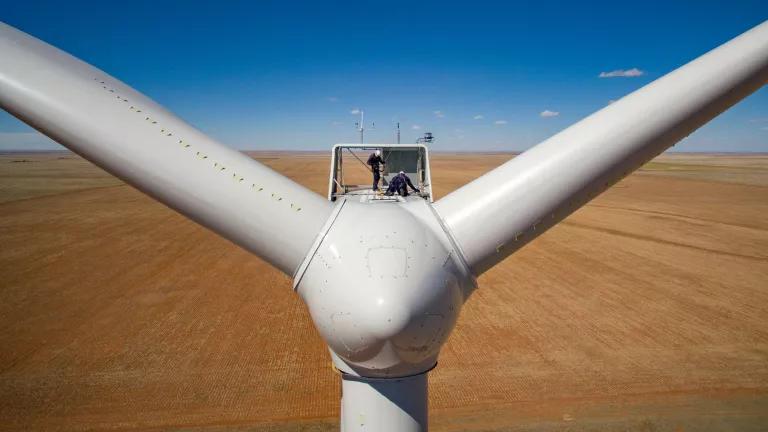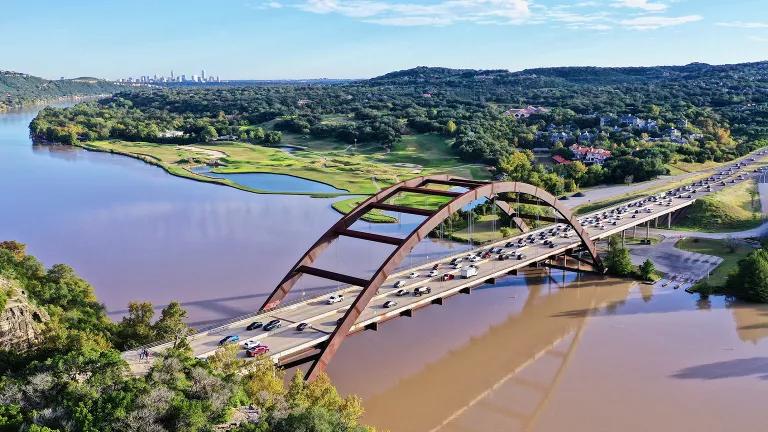
This blog is the second in an occasional series on the momentum building against Big Oil. You can read the first here.
Last year marked a watershed in the move beyond oil. And 2016 has already shown the continued erosion of Big Oil’s myth that we are stuck with its pollution and roller coaster prices at the pump. Fundamental changes in energy markets have thrown the fragility and volatility of Big Oil’s business model into sharp relief. Advances in technology exceeded optimistic predictions and put clean energy at consumer’s doorsteps. The world has awoken to the urgent need to do everything possible to turn the tide of dangerous climate change, and public momentum against going to the ends of the earth to drill for more oil has erupted across the country and globe. Big Oil’s power is slipping. And with each iota of influence lost by the exploitive industry, the likelihood that we’ll meet our climate goals improves. It is time for our elected leaders to accept the writing on the wall and reject the oil industry’s continued attempts to deny climate change and hold on to what history will prove to be a failed model.
Changing Economics
A report by British think tank Chatham House put a fine point on this historical transition in cold, hard terms:
“The future of the major international oil companies (IOCs) – BP, Chevron, ExxonMobil, Shell and Total – is in doubt. The business model that sustained them during the 20th century is no longer fit for purpose. As a result, they are faced with the choice of managing a gentle decline by downsizing or risking a rapid collapse by trying to carry on business as usual.”
Another report by the financial specialists at Carbon Tracker shows that Big Oil’s bottom line would be best served by shifting the corporations’ growth strategies away from the high cost—in terms of both capital and carbon—marginal reserves like the Arctic and tar sands. Instead, the Economist reported, they would “produce higher returns if they carry out selective drilling of low-cost wells.”
Case in point, an investigation published recently by Oceana revealed that the oil majors may be beginning to see the light: Conoco Phillips, Statoil and others have relinquished their oil and gas leases in the Arctic’s Chukchi Sea, investments worth $2.5 billion. And last week, Royal Dutch Shell officially abandoned its effort to extend the terms of its Arctic leases after the Department of Interior declared it would not renew current existing leases.
More explicitly, Total recently ruled out future Arctic oil drilling entirely and “decided to reduce [its] exposure in Canada’s [tar] sands, which are particularly expensive to develop and operate,” basing the decision on the International Energy Agency’s 2°C scenario. It’s also made substantial purchases of solar power and energy storage firms and some believe it’s making moves to become a “green giant” in the near future.
“COP21 was definitely a watershed,” Total’s chief executive officer wrote. “195 countries managed to unite around an ambitious climate agreement. That sends a strong message.”
Similarly, Statoil recently secured a lease off the coast of Scotland to build the world’s largest floating wind farm and has set aside $200 million for further clean energy investments over four to seven years while Royal Dutch Shell allocated the same sum each year for “New Energies” acquisitions.
Transportation Decarbonization
At the same time, clean energy is advancing at record pace, punching a hole in Big Oil’s increasingly flimsy rhetoric that “we are stuck with oil forever.” Last year, EV sales grew 60 percent worldwide. Analysts predicted strong EV sales growth this year and so far they’re up 13 percent compared to the same time last year, according to InsideEVs.com. By 2040, Bloomberg New Energy Finance predicted, electric vehicles will account for 35 percent of new car sales globally and displace 13 million barrels a day of crude, causing the next oil crisis.
But in light of Tesla Motors’ April pre-sale of its forthcoming mid-range sedan, it’s possible that all of these forecasts will be shattered. In just seven days, the EV and battery company received more than 325,000 online reservations of its yet-to-be released Model 3 and more are still being made. To put that into comparison, only around 116,000 EVs were sold in all of 2015 and Honda’s best-selling car, the Accord, broke records in 2015 with 388,000 purchases. Tesla has broken open the consumer market for electric vehicles in a way that promises to further accelerate the accessibility of clean vehicles.
Tragedies We Can Avoid...
Oil poses a clear and present danger to our communities and our planet, evidenced further by yet another slate of recent oil spills. Last month, on June 23rd, a pipeline near Ventura, CA, opened up, leaking around 29,400 gallons of crude into an arroyo leading to the Pacific. As was the case with last year’s spill onto Santa Barbara’s beaches, this went undetected by the pipeline company and may not have been contained but for a local rancher who woke up to the smell of noxious fumes and contacted 911.
In May, it was discovered that a Shell facility leaked nearly 90,000 gallons into the Gulf of Mexico, leaving a two-by-thirteen mile oil sheen on the water’s surface.
And early last month a train carrying crude oil derailed near a small town along the Columbia River in Oregon, forcing evacuations. Oil from the punctured train cars eventually found its way into the river. These ‘accidents’ remind us of the immediate destruction that is an unavoidable consequence of oil extraction and transportation. In response to the Oregon derailment, Oregon Senator Ron Wyden told the Los Angeles Times, "It's clear with this crash -- as it has been for years -- that more must be done to protect our communities from trains carrying explosive hazardous fuels,” and the state pressed for an indefinite moratorium on the passage of “bomb trains” through its borders.
…But Not Without Strong Leadership
The trend towards a safer planet has only been reinforced by rapidly changing politics.
The Obama administration has continued to send strong messages via bi-lateral and multi-lateral agreements that clean—not dirty energy—must power the future. Just last week at the “Three Amigos” summit, the President and Mexico and Canada’s leaders together took aim at generating half of their energy cleanly by 2025. At the recent U.S.-Nordic Leader Summit, President Obama committed to applying the precautionary principle when considering new oil and gas operations in the Arctic. And he made a similar pledge after meeting with the new Canadian Prime Minister in March, and shortly thereafter removed the U.S. Atlantic coast from its proposed 5-year offshore leasing plan.
In short: momentum is shifting, but Big Oil has yet to give up the ghost. Despite progress, it is clear that much of the industry continues to advocate hard to open vast new areas to oil production, regardless of harm to communities, the environment, and the climate. The decisions our elected leaders make will help determine whether this change in momentum against Big Oil results in a smooth transition to clean energy on a timeline that meets the urgency of climate change, or a disruptive upheaval that comes far too late for the global climate.
For example, President Obama faces one such pivotal decision as he finalizes the Bureau of Ocean Energy Management’s (BOEM) five-year offshore oil and gas leasing program for 2017-2022. Once leases are sold it would take decades before any product comes to market. So the President’s offshore leasing plans represent a blueprint for the future. A blueprint that suggests we will need the oil contained under the Arctic and Atlantic oceans to meet national demand in 2040 means we are planning on progress stalling, allowing our global climate to warm beyond 2°C. That’s why President Obama should permanently withdraw the Arctic and Atlantic Oceans from all future oil and gas leasing and prevent the expansion of leasing in the Gulf.
It is also imperative that our elected leaders continue to invest in clean energy solutions and oppose the expansion of tar sands and other unconventional fuels, development which continues to threaten our communities, waterways, and climate. We must tighten the rules to accelerate clean transportation systems, and ensure that the transportation of tar sands and other dirty oils does not put our communities or oceans at risk by increasing pipeline safety and oversight, placing a moratorium on crude oil unit trains, and instituting a moratorium on tankers and barges hauling tar sands crudes on our major rivers and off our coasts.
We do not have to face the reality being pushed by the oil industry. Oil—as a product and an industry—is losing its gravity. We’re moving beyond it and can accelerate that transition if our leaders keep sending the message that they believe in a clean energy future. It’s what the best market analysts are saying is a good investment, it’s what climate science says we must do, and it’s the global model of leadership President Obama has made his calling card.
Our society is poised for a clean energy revolution—our President should continue to use his last months in office to do all he can to make it a reality.



